Chellah
The Chellah or Shalla (Berber languages: Sla or Calla; Arabic: شالة),[1][2] is a medieval fortified Muslim necropolis located in the metro area of Rabat, Morocco, on the south (left) side of the Bou Regreg estuary. The Phoenicians established a trading emporium at the site.[3][4] This was later the site of an ancient Roman colony[5] in the province of Mauretania Tingitana.
Sla / Calla (Shalla) | |
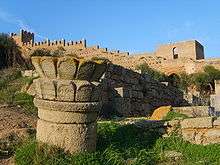 Part of the interior of the walled Chellah complex | |
 Shown within Morocco | |
| Alternative name | Sala Colonia (name of Roman colony) |
|---|---|
| Location | Rabat, Rabat-Salé-Kénitra, Morocco |
| Coordinates | 34°00′24″N 06°49′13″W |
| Type | Necropolis |
| History | |
| Abandoned | 1154 AD |
Salā was the name given to the city founded by the Muslim conquerors of North Africa, which was mostly abandoned during the Almohad era, then rebuilt by the Marinids in the 13th century. The ruins of their medieval fortress are still extant. The Berber Almohads used the site as a royal burial ground. The Marinids made the site a holy necropolis, or chellah, and built a complex that included mosque, minaret, and royal tombs. The tall minaret of the now-ruined mosque was built of stone and zellige tilework, and still stands.
Contrary to legend, the corsairs of Salé did not actually operate out of Salé (called "Old Salé"), but out of the city that would later become known as Rabat, ("New Salé") on the south (left) bank of the Bou Regreg.[6][7][8]
History
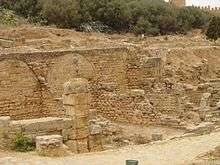
Phoenician Sala
The Phoenicians founded several trading colonies in what is now Morocco. The settlement along the banks of the Bou Regreg was known as Shalat (Punic: 𐤔𐤏𐤋𐤕, šʿlt).[9][10] It was later controlled from Carthage.[11]
Roman Sala Colonia
The Romans later built their own city, Sala Colonia, very near the same site. The Roman town was referred to as "Sala" by Ptolemy.[12] Excavations show a substantial port city with ruined Roman architectural elements including a decumanus maximus or principal roadway, a forum and a triumphal arch.[13] Sala was a center of Christianity from the 2nd century.
One of the two main Roman Roads in Mauretania Tingitana reached the Atlantic through Iulia Constantia Zilil (Asilah), Lixus (Larache) and Sala Colonia. Another may have been built towards the south, from Sala to modern Casablanca, then called Anfa. The Romans had two main naval outposts on the Atlantic coast of the province: Sala Colonia, and Lixus. The port of Sala (now disappeared) was used by commercial Roman ships as a way station on their southwestward passages to Anfa and the Insula Purpuraria (Mogador island).[14]
Sala remained linked to the Roman Empire even after the withdrawal in the 4th century of the occupying Roman legions to Tingis and Septem in northern Mauretania Tingitana. A Roman military unit remained there until the end of the 5th century. Archaeological objects of Visigothic and Byzantine origin found in the area attest to the persistence of commercial or political contacts between Sala and Roman Europe, up to the establishment of a Byzantine presence in Berber North Africa during the 7th century.[15]
Muslim Salā
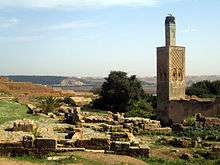
Sala continued to exist as a town of the Christianized Berbers, but was mostly in ruins when the Muslim Arabs arrived in the 7th century. The Byzantine governor of the area, Count Julian of Ceuta, surrendered to Uqba ibn Nafi in 683.[16] Around 1030, the town of Salā was founded at the site by the Banu 'Ashara family.[17][18] With the extinction of the Umayyad dynasty in 1031, the Almoravids assumed control of the Maghreb (present-day Tunisia, Algeria, Morocco) and erected new buildings in Salā.[19] They rebuilt the Great Mosque of Salā on the site of the mosque of the Banu 'Ashara, completing it in 1196.[20]
By 1147, the Almoravids had been overthrown by the Berber Almohads, who used the site as a royal burial ground. It was made a sacred necropolis, or chellah, by the Marinids in the 13th century; the Muslim sanctuary complex of mosque, minaret, and royal tombs being built by Abu Yusuf Yaqub, and finished in 1284. His remains were moved to the necropolis after he died at Algeciras in 1286. The tall minaret of the now-ruined mosque was built of stone and zellige tilework, and still stands.[1] Near the minaret is the tomb of the Maranid ruler, Abu al-Hasan Ali ibn Othman, known as the Black Sultan.
Many of the remaining structures in Chellah were damaged by the 1755 Lisbon earthquake. The site has been converted to a garden and tourist venue, and today it is included in the metropolitan area of Rabat.
Music Venue
Since 2005, the ruins of Chella host an international "Festival of Jazz" each year, called Jazz au Chellah.[21] Additionally, it is currently home to a venue of the annual Mawazine music festival in Rabat, usually showcasing jazz or traditional music, as opposed to more popular contemporary music featured at some of the larger venues.[22]
World Heritage Status
The site, as part of the metropolitan Rabat, was granted World Heritage Status in 2012. [23] [24] [25]
See also
- Berbers
- Colonia (Roman)
- Exploration of Africa
- Mauretania Tingitana
- Roman roads in Morocco
- Volubilis
Gallery
- Chellah Ramparts
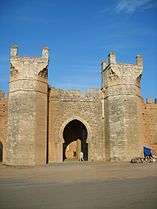 Chellah necropolis entrance
Chellah necropolis entrance_5.jpg) Chellah necropolis interior
Chellah necropolis interior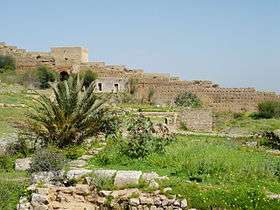 Chellah Ruins
Chellah Ruins
References
Citations
- Sheila Blair; Jonathan M. Bloom (1995). The Art and Architecture of Islam 1250–1800. Yale University Press. p. 123. ISBN 978-0-300-06465-0.
- Islam art et géométrie. BASTIEN. p. 136. GGKEY:7T9G0W44YER.
- Glenn Markoe (2000). Phoenicians. University of California Press. p. 188. ISBN 978-0-520-22614-2.
- Anna Gallina Zevi; Rita Turchetti (2004). Méditerranée occidentale antique: les échanges. Atti del seminario (Marsiglia, 14–15 maggio 2004). Ediz. francese, italiana e spagnola. Rubbettino Editore. p. 224. ISBN 978-88-498-1116-2.
- Kenneth L. Brown (1 January 1976). People of Salé: Tradition and Change in a Moroccan City, 1830–1930. Manchester University Press. p. 1. ISBN 978-0-7190-0623-4.
- Salma K. Jayyusi; Renata Holod; Attilio Petruccioli; Andre Raymond (August 2008). The City in the Islamic World. 94/1 & 94/2. BRILL. p. 653. ISBN 90-04-16240-2.
- Roger Coindreau (2006). Les corsaires de Salé. Eddif. pp. 45–46. ISBN 978-9981-896-76-5.
- Jerome B. Bookin-Weiner (January 1990). "The Sallee Rovers: Morocco and its Corsairs in the Seventeenth Century". In Reeva S. Simon (ed.). The Middle East and North Africa: Essays in Honor of J.C. Hurewitz. Middle East Institute, Columbia University. p. 310, note 4. ISBN 978-0-231-07148-2.
- Head & al. (1911), p. 889.
- Ghaki (2015), p. 67.
- Janet L. Abu-Lughod (14 July 2014). Rabat: Urban Apartheid in Morocco. Princeton University Press. pp. 37–38, note 2. ISBN 978-1-4008-5303-8.
- Sala Colonia (in French) Archived May 31, 2014, at the Wayback Machine
- "Sites Antiques". www.minculture.gov.ma (in French). Rabat, Morocco: Ministry of Culture, Kingdom of Morocco. Archived from the original on November 12, 2013. Retrieved 12 June 2014.
- "Le province romane d'Africa in "Il Mondo dell'Archeologia"". www.treccani.it (in Italian). Retrieved 2018-02-24.
- Boube, J. "Éléments de ceinturon wisigothiques et byzantins trouvés au Maroc".Bulletin d'archéologie marocaine, volume=XV, 1983–84.pages=281–297
- William Darrach Halsey, ed. (1981). Collier's Encyclopedia, with Bibliography and Index. Macmillan Educational Corporation. p. 560.
(Ommiad) caliphs of Damascus, arrived in a.d. 682 under the command of Uqba ibn- Nafi. Uqba obtained the submission of Count Julian and advanced to the Sous.
- Rachid El Hour (1 January 2000). "The Andalusian Qāḍī in the Almoravid Period: Political and Judicial Authority". Studia Islamica. Maisonneuve & Larose (90): 80. doi:10.2307/1596165.
With regard to the judicial administration in the Maghreb,the Almoravids gave the judicial functions to local families. For example in Sale, the Banu 'Ashara family, a very rich family...
- Oleg Grabar (31 December 1990). Muqarnas: An Annual on Islamic Art and Architecture. BRILL. p. 65. ISBN 90-04-09347-8.
- Janet L. Abu-Lughod (14 July 2014). Rabat: Urban Apartheid in Morocco. Princeton University Press. p. 35. ISBN 978-1-4008-5303-8.
- Janet L. Abu-Lughod (14 July 2014). Rabat: Urban Apartheid in Morocco. Princeton University Press. p. 57. ISBN 978-1-4008-5303-8.
- Jazz au Chellah (in French) Archived July 27, 2010, at the Wayback Machine
- http://www.festivalmawazine.ma/en/accueil/
- "Rabat, Modern Capital and Historic City: a Shared Heritage". UNESCO. 2012. Retrieved 2013-10-06.
- "Rabat". World Heritage Site. September 2013. Archived from the original on 2013-08-17. Retrieved 2013-10-06.
- "Rabat Named UNESCO World Heritage Site". Caribbean News Digital. 2012-11-23. Archived from the original on 2014-02-22. Retrieved 2013-10-06.
Bibliography
- Ghaki, Mansour (2015), "Toponymie et Onomastique Libyques: L'Apport de l'Écriture Punique/Néopunique" (PDF), La Lingua nella Vita e la Vita della Lingua: Itinerari e Percorsi degli Studi Berberi, Studi Africanistici: Quaderni di Studi Berberi e Libico-Berberi, No. 4, Naples: Unior, pp. 65–71, ISBN 978-88-6719-125-3, ISSN 2283-5636. (in French)
- Head, Barclay; et al. (1911), "Mauretania", Historia Numorum (2nd ed.), Oxford: Clarendon Press, pp. 887–890.
External links
| Wikimedia Commons has media related to Chellah. |
%2C_Algeria_04966r.jpg)
